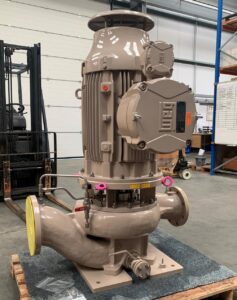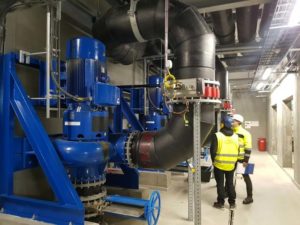HI Updates Sealless Rotodynamic Pump Standard and Sealless Magnetically Driven Rotary Pump Standard
The Hydraulic Institute (HI) has updated the 2000 edition of the ANSI/HI standard on sealless centrifugal pumps and published ANSIHI 5.1-5.6—2010 Sealless Rotodynamic Pumps for Nomenclature, Definitions, Application, Operation and Test. The revised standard covers sealless rotodynamic pumps driven by canned motors or through magnetic couplings with conventional motors.
ANSI/HI 5.1 – 5.6—2010 is designed to provide users with information necessary to define and describe the construction features and benefits of using sealless pumps and contains a number of significant updates and enhancements. They include: pump part names and definitions, magnetic temperature limits and motor insulation temperature limits, magnetic drive pumps mounting specifications, and new monitoring device information. In addition, the new standard provides users with expanded information in the test sections that cover types of tests, parameters, procedures, and acceptance criteria.
“Sealless pumps are typically used when there is a need to contain toxic, dangerous, or valuable liquids or when specific applications warrant their use. Application may be dictated by environmental, safety, noise, or space concerns. Canned motor pumps and magnetic drive pumps both have a driven shaft that is completely contained within a pressurized boundary that contains the pumped liquid. Shaft loads are supported by product or external flush liquid-lubricated bearings. This configuration minimizes the chances for leakage because there is no shaft penetration of the pressure containment boundary.” indicated Gregg Romanyshyn, Technical Director of HI.
Under the leadership of Roger Turley, Flowserve Pump (Flow Solutions Group), and Peter Gaydon, Chempump, a Division of Teikoku USA, the committee incorporated current sealless pump technology in this standard. Leading sealless pump manufacturers who contributed to this standard include Chempump, Flow Solutions Group, ITT – Industrial Process, and Iwaki America Incorporated.
The Hydraulic Institute has also updated its standard ANSI/HI 4.1-4.6–2010 Sealless, Magnetically Driven Rotary Pumps. This standard covers the unique features of these pumps and includes sections on types and nomenclature; definitions; design and applications; installation, operation, and maintenance; and testing of these pumps. Magnetically driven pumps use permanent magnets to transmit torque through a containment shell that separates two sets of magnets. These pumps have a driven shaft that includes the pumping elements and is completely contained within the pressurized boundary surrounding the process liquid.
According to Gregg Romanyshyn, “Sealless rotary pumps combine the advantages of a positive displacement pump that is capable of pumping viscous liquids and liquids sensitive to shear with the ability to contain toxic, dangerous, or valuable liquids or when specific applications or flow/pressure requirements warrant their use. These applications may be dictated by environmental, safety, noise, or space concerns. This standard will help both users and manufacturers properly apply sealless rotary pumps to those services in which leakage to the environment is a concern. In addition, the procedures for hermetic integrity testing have been updated by the committee.”
John Owen, IMO Pump - Colfax Corp., and Alan Wild, Moyno, Inc., led the committee that developed the standard, which included representatives from: Flowserve Pump Division, Leistritz Corporation, Intelliquip LLC, IMO Pump, Milton Roy Americas, Moyno, Inc., Roper Pump Company, Siemens Water Technologies, and Weir Floway, Inc.
HI Pump Standards are reliable, widely accepted references for anyone involved in pumps, including users, consultants, contractors, construction firms, manufacturers of pumps, seals, motors, instrumentation, controls, and pump software developers and systems integrators. HI periodically introduces new Standards based on industry needs. HI’s complete library of ANSI/HI standards for the pump industry is user-friendly, and available in both electronic and print formats at the HI eStore.
Source: Hydraulic Institute Inc.







